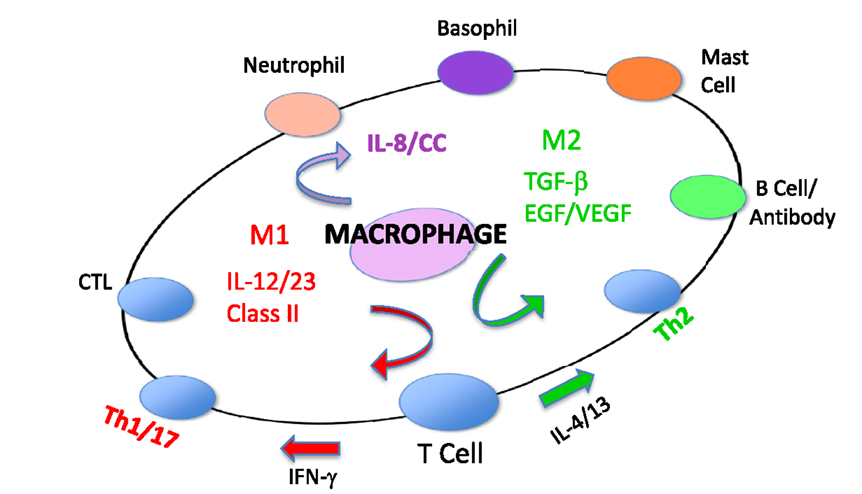
Macrophages initiate and direct other immune responses
A research team describes ‘tuning’ macrophages from ones that repair wounds (and contribute to tumor growth) to ones that sterilize wounds (and contribute to immune system’s attack of tumor tissue).
The immune system’s macrophages pick a life path. Cancers encourage macrophages to pick the path of wound-repair, making what are called “M2” or “repair-type” macrophages. Cancers use these M2 macrophages to promote their own growth. Now researchers can successfully flip M2 macrophages into their wound-sterilizing cousins, called “M1” or “kill-type” macrophages, which, contrary to promoting the growth of new tissue, may aid the immune system in clearing the body of cancer.
“The basic message we’re trying to convey is that turning those M2 macrophages into a more M1 phenotype has beneficial effects in promoting anti-tumor immunity,” says Laurel Lenz, PhD. Previous work has shown that people with a naturally high ratio of M1 to M2 macrophages are less prone to develop cancer. In mouse models of the disease, encouraging a high M1-to-M2 ratio can “slow or stop cancer growth.
In fact, there are 2 schools of thought describing how to change a population of M2 macrophages into a population of M1 macrophages. 1. M2 macrophages can reverse their differentiation to become briefly more “stem-like” before being encouraged to use their second chance to pick the more beneficial M1/kill-type phenotype. 2. As macrophages naturally die out, they could be replaced by a new population dominated by M1 macrophages. The paper describes a way to accomplish the second: In the presence of the cytokine interferon gamma, macrophages take on the M1 phenotype.
“Interferon gamma has been explored as a possible therapeutic agent, but there are problems with it,” Lenz says. “Interferon gamma mediates hundreds of effects and some of them aren’t very comfortable.” Instead, one idea is to improve the sensitivity of cells to the interferon gamma that already exists in the body. “In the right context, macrophages lose their sensitivity to interferon gamma and we want to prevent that,” Lenz says. Another approach seeks to augment interferon gamma only in tumor tissue, keeping its effects localized. “The immune system’s killer cells produce interferon gamma and one promising strategy is to get them to the tumor and activated in the right way,” Lenz says.
In fact, existing immunotherapies seek to recruit the body’s killer cells, especially cytotoxic T cells, to recognize and attack tumor tissue. A byproduct of this activation is the production of interferon gamma at the tumor site, which causes macrophages to take the M1 and not M2 phenotype. “Cytotoxic T cells can directly kill tumor cells. But they also produce interferon gamma. Both are likely contributing to the anti-tumor effect,” Lenz says. “By devising approaches to tune macrophages in the right way, we hope to further improve immunotherapies.” http://www.coloradocancerblogs.org/tuning-macrophages-a-breakthrough-in-cancer-immunotherapy/







Recent Comments